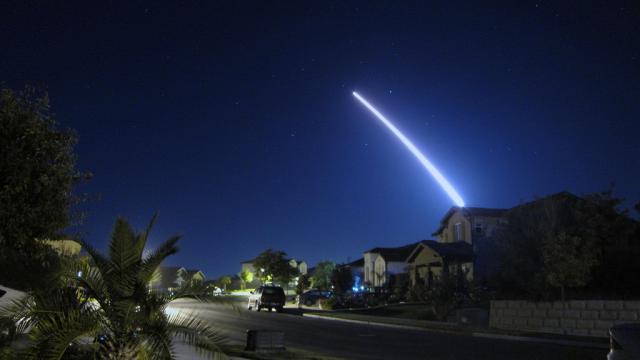The U.S. Missile Defence Agency (MDA) is reporting that its Ground-based Midcourse Defence (GMD) system has succeeded in its first attempt to shoot down an Intercontinental Ballistic Missile target (ICBM), the U.S. Department of Defence said in a press release.
An operational test launch of an unarmed Minuteman III intercontinental ballistic missile from Vandenberg Air Force Base, Calif., is seen from nearby Lompoc, Calif., Sept. 26, 2013. Credit: U.S. Air Force
The target was not an actual ICBM missile, but a simulated missile tipped with an unarmed payload, an MDA spokesperson told Foxtrot Alpha. The ICBM target was dubbed “threat-representative,” by MDA Director Navy Vice Adm. Jim Syring in the press release, meaning it performed much like could be expected from a state like North Korea.
The interceptor was fired from Vandenberg Air Force Base in California, and the ICBM target was launched from the Republic of the Marshall Islands out in the Pacific. The successful test is sure to bring some optimism to the officials in charge of the GMD system, which has been dogged with criticisms of its ineffectiveness. It is unknown if the interceptor had to seek the target among decoys, a concern many in the missile defence community fear is the GMD’s major liability. So far, the system has had a 53 per cent success rate against shorter-range missiles.
The MDA released a statement praising the results:
“The intercept of a complex, threat-representative ICBM target is an incredible accomplishment for the GMD [Ground-based Missile Defence] system and a critical milestone for this program,” said Missile Defence Agency Director Vice Adm. Jim Syring. “This system is vitally important to the defence of our homeland, and this test demonstrates that we have a capable, credible deterrent against a very real threat. I am incredibly proud of the warfighters who executed this test and who operate this system every day.”
Since 1985, the system has cost tax payers nearly $US190 ($255) billion. But, as Foreign Policy cites its article on the GMD test, it is still basically a “prototype.”
Here is more on the kind of interceptor used to during today’s test:
Tuesday’s test was the first of a new “kill vehicle,” 1.52m-long device which steers itself into the path of the oncoming missile, destroying it by the force of impact. Pentagon officials like to say that it’s like hitting a bullet with a bullet.
There are two kill vehicles currently in use among the 36 deployed interceptors in California and Alaska. A majority use the CE-I variant, that has had only seen two successfulintercept tests over four tries. The last success came in 2008. The other CE-II kill vehicle has fared even worse, having succeeded only once in three tries. None of the kill vehicles had a successful test before being fielded.
That all said, today is still a good day for the GMD system.
The challenge moving forward will be if the interceptor will be able to take on decoys. The Pentagon is working to accelerate its research into a Multi-Object Kill Vehicle that could take out a warhead and any decoys accompanying it.
